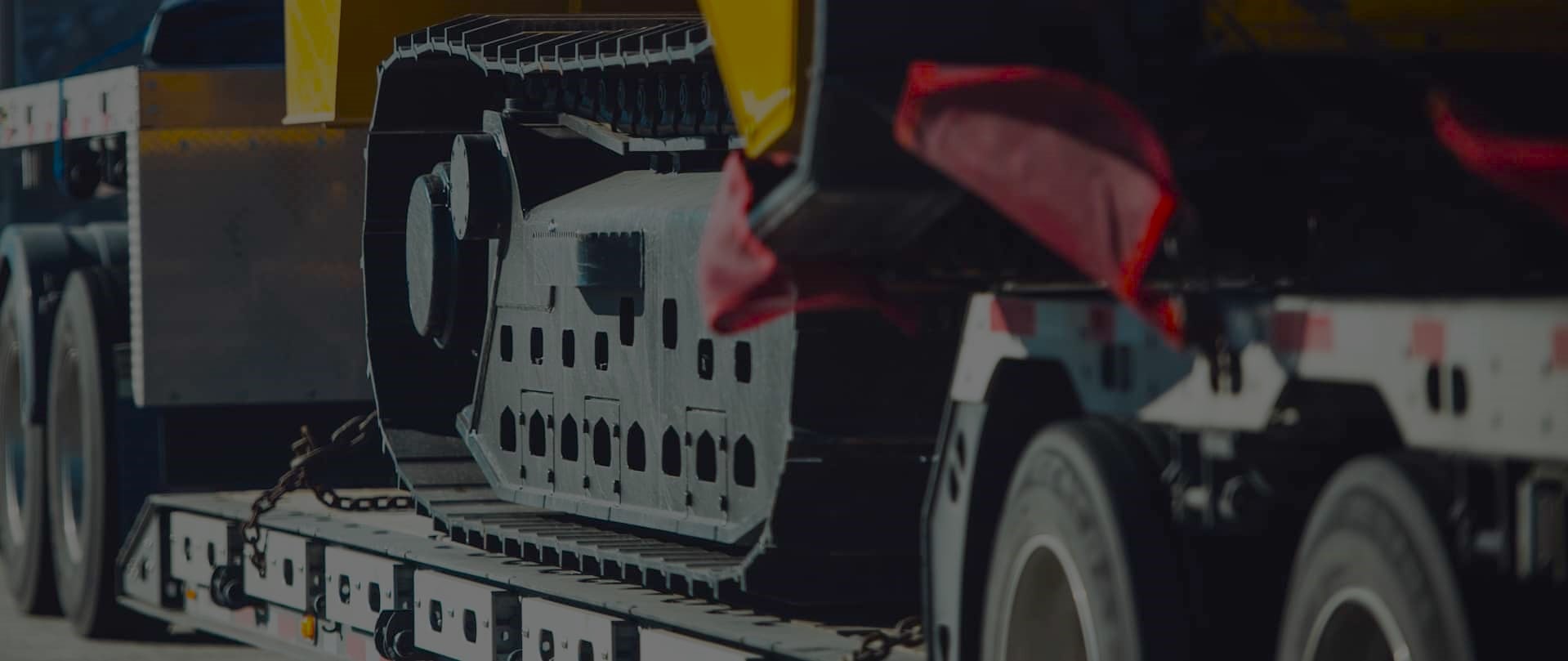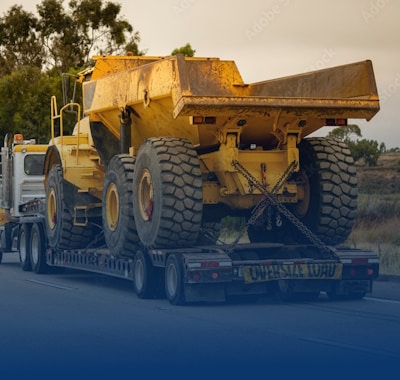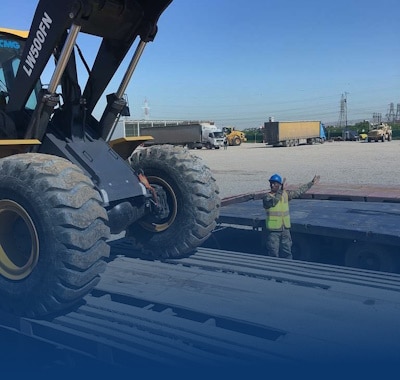Uncover the True Cost of Heavy Equipment Transport
Freedom Heavy Haul can offer expedited Pickup and Delivery for any size shipment anywhere in the USA. Contact us today for No Hassle, No Pressure Pricing.
Moving heavy equipment involves more than just loading and unloading. It requires careful planning, adherence to safety standards, and a clear understanding of the costs involved. For businesses in construction, mining, and manufacturing, these expenses can significantly impact budgets.
At our company, we specialize in heavy hauling services, ensuring your equipment arrives safely and efficiently. Our focus on cost-efficiency and regulatory compliance helps you avoid unexpected fees. We prioritize transparency, providing accurate pricing information tailored to your needs.
Understanding the variables that affect shipping costs—such as distance, equipment size, and market dynamics—is crucial. This guide will explore these factors in detail, helping you make informed decisions for your business.
Decoding the True Cost of Heavy Equipment Transport
Budgeting for the relocation of industrial equipment requires careful analysis. Several variables influence the final price, making it essential to understand the key drivers. At our company, we focus on providing transparent and accurate estimates tailored to your business needs.
Key Budget Drivers and Variables
The size and weight of your machinery play a significant role in determining the rate. Larger or heavier equipment often requires specialized trailers, which can increase costs. Additionally, the distance of the shipment impacts the price, as longer hauls involve more fuel and labor.
Businesses must also consider operational needs. For example, time-sensitive deliveries may incur higher rates due to expedited services. Understanding these factors helps in creating a realistic budget for your project.
Understanding Regional Price Variations
Regional differences can significantly affect shipping prices. Local regulations, infrastructure quality, and fuel costs vary across states, influencing the final rate. For instance, urban areas with heavy traffic may lead to higher expenses compared to rural routes.
We analyze these variations to provide accurate quotes. By understanding regional dynamics, we ensure your equipment arrives safely and within budget.
| Distance (Miles) | Average Price per Mile | Expected Delivery Time |
|---|---|---|
| 0-100 | $3.50 | 1-2 Days |
| 101-500 | $2.80 | 3-5 Days |
| 501+ | $2.20 | 6-10 Days |
For more insights on selecting the right transport company, visit our guide on how to choose a heavy equipment transport. This resource provides valuable tips to ensure a smooth and cost-effective process.
Understanding the Heavy Equipment Transport Landscape
The heavy equipment transport sector is shaped by evolving market trends and strict safety protocols. Businesses must navigate these complexities to ensure efficient and secure shipment of their machinery. At our company, we combine industry expertise with a commitment to safety, helping you stay ahead in this dynamic field.
Industry Insights and Market Dynamics
The transport market is influenced by factors like fuel prices and demand fluctuations. Rising fuel costs can significantly impact equipment shipping rates, while seasonal demand often leads to price variations. Understanding these trends allows businesses to plan effectively and minimize expenses.
We monitor market dynamics closely to provide cost-effective services. By staying informed, we ensure your shipment is handled efficiently, regardless of external factors.
Safety and Regulatory Considerations
Safety is a top priority in heavy equipment transport. Adhering to strict standards ensures the secure movement of machinery. Oversized loads often require special permits, adding another layer of complexity to the process.
Our team is well-versed in regulatory requirements, ensuring compliance at every step. From securing permits to implementing safety protocols, we handle the details so you can focus on your business.
“Safety and compliance are not just regulations—they are the foundation of trust in heavy equipment transport.”
- Stay informed about market trends to optimize service costs.
- Adhere to safety standards to protect your machinery and personnel.
- Ensure proper permits are obtained for oversized shipments.
Critical Factors Influencing Shipping Rates
Shipping rates for industrial machinery are influenced by several critical elements. Understanding these factors helps businesses plan effectively and avoid unexpected expenses. At our company, we analyze these variables to provide accurate cost estimates tailored to your needs.
Equipment Size, Weight, and Complexity
The dimensions and technical complexity of your machinery play a significant role in determining shipping costs. Larger or heavier equipment often requires specialized trailers, increasing the overall cost. Additionally, complex machinery may need extra handling, adding to the expense.
Fuel Pricing and Market Demand
Fuel prices and market demand directly impact rate fluctuations. Rising fuel costs can significantly increase shipping expenses, while high demand during peak seasons often leads to higher rates. We monitor these trends to offer competitive pricing.
Impact of Transportation Distance
The distance of your shipment is another key factor. Longer hauls involve more fuel and labor, raising the overall cost. Remote locations may also pose logistical challenges, further increasing expenses.
| Distance (Miles) | Average Price per Mile | Expected Delivery Time |
|---|---|---|
| 0-100 | $3.50 | 1-2 Days |
| 101-500 | $2.80 | 3-5 Days |
| 501+ | $2.20 | 6-10 Days |
Additional expenses, such as permit fees and insurance premiums, can also raise the overall cost. We ensure all necessary permits are secured and provide comprehensive insurance coverage for your peace of mind.
“Accurate cost forecasting is the key to avoiding unexpected fees and ensuring a smooth delivery process.”
By understanding these factors, businesses can make informed decisions and plan their budgets effectively. We prioritize transparency, providing detailed quotes that account for all variables, including location and delivery requirements.
Equipment Dimensions: How Size and Weight Impact Costs
Understanding the dimensions of your machinery is key to efficient transport planning. The size and weight of your equipment directly influence the resources and strategies required for safe and cost-effective equipment transport. Accurate measurement ensures that every aspect of the process is optimized, from route planning to load securing.
Specialized Shipping Techniques
Handling oversized or heavy machinery often requires specialized techniques. For instance, larger dimensions may necessitate the use of lowboy trailers or modular transporters. These methods ensure the safe movement of equipment while minimizing risks.
Precision in load planning is another critical factor. By calculating the exact dimensions and weight, we can determine the most efficient route and equipment needed. This approach not only enhances efficiency but also reduces unnecessary expenses.
“Accurate measurement and planning are the cornerstones of successful industrial machinery shipping.”
- Specialized trailers and handling techniques are essential for oversized loads.
- Precision in load planning leads to safer and more cost-effective transport.
- Understanding equipment dimensions helps in selecting the right resources.
For more insights on handling complex shipments, explore our guide on industrial machinery shipping. This resource provides valuable tips to ensure a smooth and efficient process.
By focusing on the technical aspects of equipment transport, we ensure that every shipment is handled with care and precision. Our expertise in the industry allows us to meet your specific needs while maintaining the highest standards of safety and efficiency.
Trailer Types and Loading Challenges in Equipment Transport
Selecting the right trailer for equipment hauling is crucial for efficiency and safety. The choice of trailer impacts not only the transportation cost but also the ease of loading and unloading. We specialize in matching the right trailer to your specific needs, ensuring a seamless process from start to finish.
Comparing Flatbed, Step Deck, and Lowboy Options
Flatbed trailers are versatile and ideal for standard-sized machinery. They offer easy access for loading but may not suit oversized equipment. Step deck trailers provide a lower deck height, making them suitable for taller loads. Lowboy trailers, on the other hand, are designed for heavy and oversized machinery, offering the lowest deck height for maximum clearance.
Each trailer type has its benefits and limitations. Flatbeds are cost-effective for standard loads, while lowboys are essential for complex hauling. We analyze your equipment’s dimensions and weight to recommend the best option, optimizing both pricing and safety.
Managing Loading and Unloading Complexities
Loading and unloading heavy machinery require precision and expertise. Flatbeds offer straightforward access but may need additional securing for tall loads. Step decks and lowboys, while more complex to load, provide better stability for oversized equipment.
We address these challenges by using specialized equipment and trained personnel. Our team ensures that every load is securely fastened, minimizing risks during transit. This attention to detail reduces delays and enhances overall efficiency.
“The right trailer choice ensures not just cost savings but also the safety and integrity of your equipment.”
- Flatbeds are ideal for standard loads but may require extra securing for tall machinery.
- Step decks offer lower deck heights, making them suitable for taller equipment.
- Lowboys are essential for oversized and heavy machinery, ensuring maximum clearance.
Our commitment to selecting the best trailer for each job ensures that your equipment arrives safely and on time. By understanding the nuances of trailer types and loading challenges, we provide tailored solutions that meet your specific needs.
Seasonal Trends and Their Effects on Shipping Rates
Seasonal shifts play a significant role in determining shipping rates for industrial machinery. Understanding these fluctuations helps businesses optimize their budgets and plan effectively. At our company, we analyze seasonal trends to provide cost-effective solutions tailored to your needs.
Peak Demand vs. Off-Peak Opportunities
Shipping rates often rise during peak demand periods, such as harvest seasons or construction booms. During these times, higher demand for transport services leads to increased costs. Conversely, off-peak periods offer opportunities for savings, as lower demand results in more competitive rates.
We help businesses identify these windows to align their shipments with cost-effective timing. By planning strategically, you can minimize expenses without compromising on efficiency.
Strategies for Managing Budget Commitments
Aligning your budget with seasonal trends requires careful planning. One effective strategy is to schedule shipments during off-peak periods whenever possible. This approach reduces costs while ensuring timely delivery.
Another key factor is selecting the right transportation model. For instance, choosing a flexible route or combining shipments can further optimize your budget. We work closely with you to develop tailored solutions that meet your financial and operational goals.
“Proactive planning is the key to navigating seasonal rate fluctuations and maintaining budget control.”
Importance of Route Planning and Model Selection
Route planning plays a crucial role in managing seasonal shipping challenges. During peak periods, selecting efficient routes can help avoid delays and reduce costs. Additionally, choosing the right transportation model ensures your equipment is handled safely and efficiently.
We prioritize these factors to provide reliable and cost-effective services. Our expertise in route optimization and model selection helps you stay ahead of seasonal trends.
| Season | Average Shipping Rate Increase | Recommended Strategy |
|---|---|---|
| Spring (Construction Boom) | 15-20% | Plan shipments in advance |
| Summer (Harvest Season) | 10-15% | Combine shipments to reduce costs |
| Winter (Off-Peak) | 5-10% | Schedule shipments during this period |
By understanding seasonal trends and implementing these strategies, businesses can manage their shipping budgets effectively. We are committed to providing expert guidance and reliable services to help you navigate these challenges with confidence.
Insurance, Permits, and Hidden Fee Considerations
Transporting industrial machinery involves navigating legal and financial complexities. Understanding these factors ensures smooth operations and prevents unexpected expenses. We prioritize transparency, helping you secure accurate quotes and remain compliant.
Navigating Legal Restrictions and Special Permits
The size, weight, and type of your equipment often determine the need for special permits. Oversized or heavy loads may require additional documentation to comply with state and federal regulations. We handle these details, ensuring your shipment meets all legal requirements.
Route planning is another critical factor. Certain roads have restrictions on weight or size, necessitating alternative paths. Our team coordinates with local authorities to secure the necessary permits and avoid delays.
“Proper permits and compliance are the foundation of safe and legal equipment transport.”
Identifying and Managing Unexpected Costs
Hidden fees can quickly escalate your shipping budget. Common expenses include tolls, escort vehicle fees, and unexpected permit costs. We provide detailed quotes that account for these variables, helping you avoid surprises.
Insurance is another essential factor. Comprehensive coverage protects your investment in case of accidents or damage. We work with trusted providers to offer tailored insurance solutions for your needs.
- Secure proper permits based on equipment size and weight.
- Plan routes to comply with legal restrictions and minimize delays.
- Account for hidden fees like tolls and escort services in your budget.
For more insights on navigating these challenges, explore our guide on transporting heavy machinery. This resource provides valuable tips to ensure a smooth and compliant process.
| Common Hidden Fees | Average Cost | Prevention Strategy |
|---|---|---|
| Tolls | $50-$200 | Plan alternative routes |
| Escort Vehicle Fees | $100-$500 | Verify escort requirements in advance |
| Unexpected Permit Costs | $150-$300 | Obtain all permits early |
By understanding these considerations, businesses can manage their budgets effectively and ensure compliance. We are committed to providing expert guidance and reliable services to help you navigate these challenges with confidence.
Broadening the Scope: Logistics and Cost Calculation
Accurate cost calculation is essential for efficient logistics planning. Understanding the breakdown of expenses helps businesses optimize their budgets and make informed decisions. We focus on providing transparent and detailed cost analysis tailored to your specific needs.
Fixed vs. Variable Costs Breakdown
Logistics costs are divided into fixed and variable expenses. Fixed costs include warehouse rent, labor, and equipment maintenance. These remain constant regardless of the job size or load. Variable costs, such as fuel, packaging, and tolls, fluctuate based on the shipment requirements.
For example, fuel costs vary depending on the distance and route. Similarly, packaging expenses may increase for fragile or oversized loads. By understanding these components, businesses can better allocate resources and avoid unexpected expenses.
Strategies for Accurate Transport Cost Calculations
Calculating total logistics costs requires a detailed approach. Start by identifying all fixed and variable expenses. Then, determine the cost per shipment by dividing the total expenses by the number of units transported. This method ensures accuracy and helps in budget planning.
Practical examples include analyzing fuel consumption for long-distance jobs or estimating labor costs for complex loads. We provide tailored solutions to ensure your calculations are precise and aligned with your operational goals.
“Accurate cost forecasting is the foundation of efficient logistics planning.”
- Fixed costs like warehouse rent and labor remain consistent.
- Variable costs such as fuel and packaging vary depending on the job.
- Use cost-per-shipment calculations to improve budget accuracy.
- Explore flexible options to optimize expenses without compromising quality.
By understanding these strategies, businesses can achieve more efficient and transparent pricing models. We are committed to helping you navigate the complexities of logistics cost calculation with confidence.
Final Thoughts on Securing Reliable Equipment Transport
Ensuring smooth and secure movement of industrial machinery requires careful planning and expertise. Throughout this guide, we’ve explored critical factors like size weight, loading challenges, and regional pricing variations. Understanding these elements helps businesses make informed decisions and avoid unexpected expenses.
Selecting the right partner is equally important. An experienced team ensures proper handling, compliance, and cost efficiency. We’re committed to providing transparent pricing and tailored solutions for every shipment. Our focus on safety and reliability guarantees your equipment arrives on time and in perfect condition.
Ready to streamline your transport process? Contact us today for a free quote. Let’s work together to meet your needs and ensure a seamless experience. Trust us to handle the details while you focus on your business goals.







